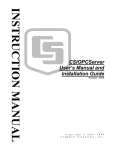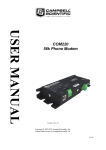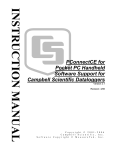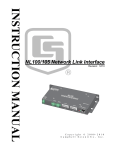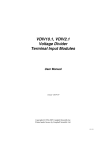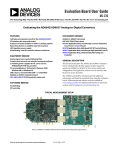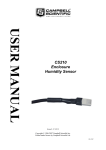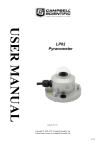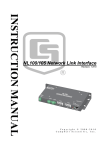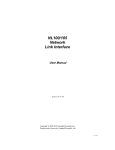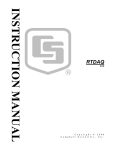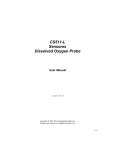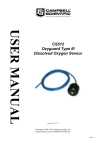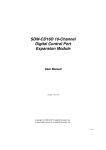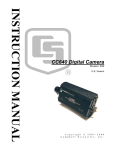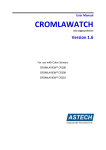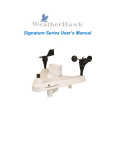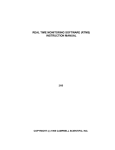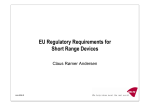Download Title page for 107 / 10TCRT manual - Bad Request
Transcript
CSIOPCServer User’s Manual and Installation Guide Isued: 24.11.09 Copyright © 2001-2009 Campbell Scientific Inc. Printed under Licence by Campbell Scientific Ltd. CSL 624 Limited Guarantee Campbell Scientific Ltd. guarantees that the installation media on which the accompanying computer software is recorded, and the documentation provided with it, are free from physical defects in materials and workmanship under normal use. Campbell Scientific Ltd. guarantees that the computer software itself will perform substantially in accordance with the specifications set forth in the operator’s manual published by Campbell Scientific. The recommended minimum hardware for CSIOPCServer is a 300 MHz Pentium II processor with 128 megabytes of RAM and a screen area of at least 800x600. CSIOPCServer uses the features of Windows NT, 2000, or XP that maximize the reliability of data collection and multitasking application programs.. The above guarantees are made for ninety (90) days (or the shortest period permitted by applicable law) from the date of original shipment. Campbell Scientific Ltd. will either replace or correct any software that does not perform substantially according to the specifications set forth in the operator’s manual with a corrected copy of the software or corrective code. In the case of a significant error in the documentation, Campbell Scientific Ltd. will correct errors in the documentation without charge by providing new media, addenda or substitute pages. If Campbell Scientific Ltd. is unable to replace defective documentation or defective media, or if Campbell Scientific Ltd. is unable to provide corrected software or corrected documentation within a reasonable time, Campbell Scientific will either replace the software with a functionally similar program or refund the purchase price paid for the software. Campbell Scientific Ltd. does not guarantee that the software will meet the licensee’s requirements or that the software or documentation are error-free or that the operation of the software will be uninterrupted. The guarantee does not cover any CD, diskette or documentation which has been altered or changed in any way by anyone other than Campbell Scientific Ltd. Campbell Scientific Ltd. is not responsible for problems caused by computer hardware, computer operating systems or the use of Campbell Scientific Ltd.’s software with non-Campbell Scientific Ltd. software. To the maximum extent permitted by applicable law, all guarantees of merchantability and fitness for a particular purpose are disclaimed and excluded. Campbell Scientific Ltd. shall not in any case be liable for special, incidental, consequential, indirect or other similar damages even if Campbell Scientific has been advised of the possibility of such damages. Campbell Scientific Ltd. is not responsible for any costs incurred as a result of lost profits or revenue, loss of use of the software, loss of data, cost of recreating lost data, the cost of any substitute program, claims by any party other than the licensee, or for other similar costs. Apart from the licensee’s statutory rights, the licensee’s sole and exclusive remedy is set forth in this limited guarantee. Campbell Scientific Ltd.’s aggregate liability arising from or relating to this guarantee or the software or documentation (regardless of the form of action, e.g. contract, tort, computer malpractice fraud and/or otherwise) is limited to the purchase price paid by the licensee. This agreement is governed by the laws of England. Where the software is not purchased directly from Campbell Scientific Ltd. alternative conditions may apply between the seller and the licensee, but these are not transferable to, or binding upon Campbell Scientific Ltd. Licence for Use This software is protected by United States copyright law and international copyright treaty provisions. The installation and use of this software constitutes an agreement to abide by the provisions of this license agreement. Campbell Scientific grants you a non-exclusive license to use this software in accordance with the following: (1) The purchase of this software allows you to install and use the software on one computer only. (2) This software cannot be loaded on a network server for the purposes of distribution or for access to the software by multiple operators. If the software can be used from any computer other than the computer on which it is installed, you must license a copy of the software for each additional computer from which the software may be accessed. (3) If this copy of the software is an upgrade from a previous version, you must possess a valid license for the earlier version of software. You may continue to use the earlier copy of software only if the upgrade copy and earlier version are installed and used on the same computer. The earlier version of software may not be installed and used on a separate computer or transferred to another party. (4) This software package is licensed as a single product. Its component parts may not be separated for use on more than one computer. (5) You may make one (1) backup copy of this software onto media similar to the original distribution, to protect your investment in the software in case of damage or loss. This backup copy can be used only to replace an unusable copy of the original installation media. This software may not be sold, included or redistributed in any other software, or altered in any way without prior written permission from Campbell Scientific. All copyright notices and labeling must be left intact. Campbell Scientific Ltd, Campbell Park, 80 Hathern Road, Shepshed, Loughborough, LE12 9GX, UK Tel: +44 (0) 1509 601141 Fax: +44 (0) 1509 601091 Email: [email protected] http://www.campbellsci.co.uk PLEASE READ FIRST About this manual Please note that this manual was originally produced by Campbell Scientific Inc. primarily for the North American market. Some spellings, weights and measures may reflect this origin. Some useful conversion factors: Area: Length: 1 in2 (square inch) = 645 mm2 1 in. (inch) = 25.4 mm 1 ft (foot) = 304.8 mm 1 yard = 0.914 m 1 mile = 1.609 km Mass: 1 oz. (ounce) = 28.35 g 1 lb (pound weight) = 0.454 kg Pressure: 1 psi (lb/in2) = 68.95 mb Volume: 1 UK pint = 568.3 ml 1 UK gallon = 4.546 litres 1 US gallon = 3.785 litres In addition, while most of the information in the manual is correct for all countries, certain information is specific to the North American market and so may not be applicable to European users. Differences include the U.S standard external power supply details where some information (for example the AC transformer input voltage) will not be applicable for British/European use. Please note, however, that when a power supply adapter is ordered it will be suitable for use in your country. Reference to some radio transmitters, digital cell phones and aerials may also not be applicable according to your locality. Some brackets, shields and enclosure options, including wiring, are not sold as standard items in the European market; in some cases alternatives are offered. Details of the alternatives will be covered in separate manuals. Recycling information At the end of this product’s life it should not be put in commercial or domestic refuse but sent for recycling. Any batteries contained within the product or used during the products life should be removed from the product and also be sent to an appropriate recycling facility. Campbell Scientific Ltd can advise on the recycling of the equipment and in some cases arrange collection and the correct disposal of it, although charges may apply for some items or territories. For further advice or support, please contact Campbell Scientific Ltd, or your local agent. Campbell Scientific Ltd, Campbell Park, 80 Hathern Road, Shepshed, Loughborough, LE12 9GX, UK Tel: +44 (0) 1509 601141 Fax: +44 (0) 1509 601091 Email: [email protected] www.campbellsci.co.uk Contents PDF viewers note: These page numbers refer to the printed version of this document. Use the Adobe Acrobat® bookmarks tab for links to specific sections. 1. What is OPC and CSIOPCServer?.............................. 1 2. Hardware/Software Requirements and Installation .. 1 2.1 Running the CSIOPCServer ..................................................................... 1 2.2 Providing Data to Multiple Computers ..................................................... 2 3. CSI’s Hardware and Software in an OPC Application ............................................................. 2 4. Identifying Data Values ............................................... 4 4.1 Data Tags .................................................................................................. 4 4.2 CSIOPCServer Browser ........................................................................... 5 5. Data Reliability ............................................................. 5 5.1 OPC Technology and Campbell Scientific Dataloggers ........................... 5 5.2 Data Quality .............................................................................................. 5 6. Technical Notes ........................................................... 6 6.1 Registering the CSIOPCServer................................................................. 6 6.2 DCOM ...................................................................................................... 6 6.3 Server and Device Operational Statistics.................................................. 6 6.3.1 Device History Statistics ................................................................. 6 6.3.2 Device “Standard” Statistics ........................................................... 7 6.3.3 Server Statistics ............................................................................. 14 i This is a blank page. CSIOPCServer 1. What is OPC and CSIOPCServer? OPC is an acronym for "OLE (Object Linking and Embedding) for Process Control". It is a set of industry standards, based on Microsoft's OLE technology, designed to provide a common interface between automation and control hardware and software. The OPC specifications were developed by a group of organizations involved in the automation and control industries in conjunction with Microsoft Corporation. CSIOPCServer is a server application developed by Campbell Scientific to provide data from its dataloggers, via LoggerNet data acquisition and management software, in an OPC format to other applications. The CSIOPCServer supports OPC Data Access Specification 2.05a. The purpose of this document is to describe how to use the CSIOPCServer to distribute information from a Campbell Scientific datalogger network to a third party OPC client. A brief overview is provided on the LoggerNet software and its role in facilitating this transfer of data. Refer to the LoggerNet User's Manual for additional information. 2. Hardware/Software Requirements and Installation A resource disk is provided that includes installation files and documentation for the CSIOPCServer. CSIOPCServer was designed to run on a PC-based computer system. A Windows NT, 2000, or XP operating system is suggested, though the application will run on Windows 95, 98, or ME. In addition, Campbell Scientific's LoggerNet data acquisition and management software (version 1.1 or higher) must be installed and running on the computer that will act as the server for the datalogger network. NOTE LoggerNet and CSIOPCServer require TCP/IP services to be installed and running on the computer. When the resource disk is inserted into the CD-ROM drive of your computer, the installation process should begin automatically. If it does not begin, access your CD-ROM drive and double-click the SETUP.EXE file. Follow the instructions on the screen to complete the installation. 2.1 Running the CSIOPCServer The CSIOPCServer is registered as a Component Object Model (COM) server in the Windows operating system during installation. Therefore, it is not necessary to manually start the application. When an OPC client is started, the CSIOPCServer will be invoked automatically. However, if the server is not invoked, or if something occurs that requires the server to be shut down, it can be started by selecting Programs | Campbell Scientific OPC Server from the Windows start button. An icon, similar to that shown above, will appear in the computer's system tray when the CSIOPCServer is active. 1 CSIOPCServer NOTE Because the CSIOPCServer registration information is written to the Windows registry, if the executable is moved to another directory the registry must be edited to reflect this change. Refer to Section 6.1 for additional information. 2.2 Providing Data to Multiple Computers The CSIOPCServer is designed to run on the same computer as the OPC client(s). Therefore, a copy of the CSIOPCServer must be running on each computer for which it will be providing data. Each licensed copy of the CSIOPCServer allows the use of the software on one computer. If multiple computers will run the CSIOPCServer, multiple licenses must be purchased. 3. CSI's Hardware and Software in an OPC Application The CSIOPCServer is used to make data available from the LoggerNet communications server to other OPC-compatible applications. The CSIOPCServer requires LoggerNet version 1.1 or higher. To better understand the role of the CSIOPCServer in an OPC application, it is helpful to review how the LoggerNet software and its clients function in a data acquisition and management network. The main component of the LoggerNet software is an application known as the LoggerNet communications server. All communication with the dataloggers occurs via the communications server. The communications server maintains a data cache (or binary database) of the data collected from the dataloggers and distributes the data simultaneously to multiple client applications for viewing, analysis, and archival. The client applications provide tools for managing the datalogger network and retrieving data from the dataloggers. Clients can run on the same computer as the communications server, or, depending upon the version of LoggerNet you are running, they can connect to the communications server over a local area network or the Internet. CSIOPCServer is a LoggerNet client. The function of the CSIOPCServer is to read the information from the data cache and make that data available to OPCcompatible clients. It must be run on each computer requiring the transfer of data from the LoggerNet communications server to an OPC client. In this sense, it is both a client and a server—it is a client to the LoggerNet communications server, and it is a server to an OPC client. 2 User’s Manual and Installation Guide The diagram below depicts the flow of information between the datalogger network, LoggerNet communications server, LoggerNet client applications, and remote clients. Datalogger Network Telecommunications LoggerNet’s Data Cache Options: * Direct Connect * Phone * RF * TCP/IP * MD485 * etc. PC Running LoggerNet Communications Server CSIOPCServer One or More PCs Running Clients (including CSIOPCServer and 3rd Party OPC Clients) OPC Clients(s) 3 CSIOPCServer Note that data must be collected from a datalogger and stored in the LoggerNet data cache before that data will be available to OPC clients. Use LoggerNet's Setup screen client to define the data tables to be collected and the schedule on which the data should be stored in the data cache. 4. Identifying Data Values 4.1 Data Tags A data tag is a text-based identifier for a specific data value that is being passed from the LoggerNet communications server to an OPC client via the CSIOPCServer. When a control in the OPC client is set up to display a data value from a datalogger, the OPC client uses the data tag to request the information from CSIOPCServer. Data tags used by CSIOPCServer are defined using a combination of the device name in the LoggerNet device map and data table and field names contained in the datalogger program. Data tags take the form of: CSIOPCServer.device_name.table_name.field_name where device_name is the name of the datalogger in LoggerNet's network map, table_name is the name of the table in the datalogger program, and field_name is the name of the variable, port, or flag for the data value being returned. CRBasic dataloggers support variable arrays (dimensioned variables). CSI OPC Server supports only single-dimensioned variables, which take the format: CSIOPCServer.device_name.table_name.field_name(array_element) Where field_name is the name of the dimensioned array and array_element is the specific variable in the dimensioned array for the value being returned. As an example, the variable array created by “Public Temp(4)” in a CR1000 program for a datalogger named WeatherCR1000 would have the data tags: CSIOPCServer.WeatherCR1000.Public.Temp(1) CSIOPCServer.WeatherCR1000.Public.Temp(2) CSIOPCServer.WeatherCR1000.Public.Temp(3) CSIOPCServer.WeatherCR1000.Public.Temp(4) Multi-dimensioned arrays are only supported if the elements of the arrays are given an alias. For example, you could use the following instructions in the CR1000 program: Public Temp(2,3) Alias Temp(1,1) = TC1 Alias Temp(2,1) = TC2 Alias Temp(1,2) = TC3 Alias Temp(2,2) = TC4 Alias Temp(1,3) = TC5 Alias Temp(2,3) = TC6 And CSI OPC Server would show tags as TC1, TC2, TC3, etc. NOTE 4 The format may vary somewhat from the examples given above, depending upon the client. User’s Manual and Installation Guide 4.2 CSIOPCServer Browser The CSIOPCServer allows OPC Universal Tag compliant browsing so that data tag names can be searched for from within an OPC application. The browser provides a list of all dataloggers in the network map and their associated data tables. The datalogger devices and their tables are presented in a directory-tree type structure, with variable names displayed under their respective tables. Multidimensional variables are presented with the name of the dimensioned variable as part of the directory-tree structure, with each variable in the array listed as a separate element. NOTE The browser is a tool of convenience—it is not necessary to assign data tags using the browser. Data tag names can be typed in directly, in the format described above. 5. Data Reliability 5.1 OPC Technology and Campbell Scientific Dataloggers OPC technology relies on consistent data from the OPC server. It expects that the structure of the data being passed from the server will not change. Therefore, it does not readily accommodate changes that occur if a new program is downloaded to a datalogger. If changes are made to the datalogger program or the LoggerNet device map, it may be necessary to shut down and restart the OPC client before the client will recognize the data from the new device. Whether or not this is necessary will depend upon whether the OPC client stores device and table information or queries the server for the information at regular intervals. The OPC Data Access Specification 2.05a supported by the CSIOPCServer is designed for real-time monitoring and control. It does not lend itself very well to historical trending. The data value passed to the OPC client is always the most recent value stored in the data cache. Because of this, if data is stored in a datalogger on a one-second interval, and that data is being collected using LoggerNet on a five-second interval, then the information passed to the OPC client will be missing some data points. If viewing historical trends is important, then the data should be exported to a file or one of the other LoggerNet clients should be used instead of CSIOPCServer. 5.2 Data Quality CSIOPCServer will assign the data quality of "Bad" to any value that it determines is missing or stale. Situations that may return a "Bad" data quality include: • The specified data tag does not exist in the datalogger table (because an error was typed when entering the data tag directly, a new program was downloaded to the datalogger, or the data tag was removed from the datalogger program). • The table for a specified data tag does not exist or is not being collected by the LoggerNet communications server. • The LoggerNet communication server has entered a Secondary Retry state with the datalogger because of communication failure with the device. 5 CSIOPCServer • The data value retrieved from the datalogger is out of range and is returned as NaN (not a number). In instances where the data tag existed but has been removed from the program or from collection, once the situation is resolved collection of that value will resume automatically. If the Bad data quality is due to communication with the datalogger being in a secondary retry state, the display of good data values will resume when LoggerNet restores normal communication with the datalogger. 6. Technical Notes 6.1 Registering the CSIOPCServer If the CSIOPCServer executable is moved to a different directory or if that directory is renamed, it will be necessary to re-register the server for it to run automatically when an OPC client is started. Open a command prompt screen and change to the directory in which the executable resides. Then type: CSIOPCServer /RegServer In some instances, you may wish to remove the CSIOPCServer application as a COM server from your computer. Open a command prompt and change to the directory in which the executable resides. Then type: CSIOPCServer /UnregServer 6.2 DCOM CSIOPCServer has not been tested for DCOM compatibility. Therefore, DCOM implementation is not supported by Campbell Scientific. We do not support running the CSIOPCServer on one DC to feed ODC clients on other PCs. 6.3 Server and Device Operational Statistics The server controller and individual devices maintain statistics that help to describe their operation. These statistics are made available to the clients in a collection of tables associated with a virtual device. It is represented by _ _statistics_ _ in the communications server. Each device in the network map is represented by two tables in the statistics device. The names of these tables are the result of appending the strings “_hist” and “_std” to the device name. The network controller also maintains statistics regarding the operation of the communications server as a whole. These statistics are available in the “_ _LgrNet_ _ _ _controller_ _” table. 6.3.1 Device History Statistics The name of a history table for a device is the result of appending the string “_hist” to the device name. This table consists of three columns and has a row size of 144. A new record for the table is generated every ten minutes. This allows the table to describe the operation of the datalogger over the last 24 hours. The counters for this table are set to zero at the beginning of each ten-minute interval. The columns for this table are as follows: 6 User’s Manual and Installation Guide 6.3.1.1 Attempts Type: uint4 Description: Records the total number of communications attempts the device made during the ten-minute interval. This counter is incremented by one for every entry that appears in the communications status log and is associated with the device. 6.3.1.2 Failures Type: uint4 Description: Records the total number of communications failures that the device experienced during the ten-minute interval. This counter is incremented by one for every “F” record that appears in the communication status log and is associated with the device. 6.3.1.3 Retries Type: uint4 Description: Records the total number of retries that the device experienced during the ten-minute interval. This counter is incremented by one for every “W” record that appears in the communication status log and is associated with the device. 6.3.2 Device “Standard” Statistics The name of the standard statistics table associated with a device is the result of appending the string, “_std” to the device name. This number of columns in this table is variable depending on the device type and the version of the LoggerNet server, although there are statistics that are common to all. 6.3.2.1 Communication Enabled Type: boolean Applies to: all device types Description: Relates whether communication is enabled for this device. 6.3.2.2 Average Error % Type: float Applies to: all device types Description: A running average of the number of “W” or “F” messages that are logged in the communication status log for the device versus the total number of messages logged. 7 CSIOPCServer 6.3.2.3 Total Retries Type: uint4 Applies to: all device types Description: A running total of the number of communication retry events that have been logged since the device was started or the statistic was last reset. 6.3.2.4 Total Failures Type: uint4 Applies to: all device types Description: A running total of the number of communications failure events that have been logged since the device was started or the statistic was last reset. 6.3.2.5 Total Attempts Type: uint4 Applies to: all device types Description: A running total of the total number of communications attempts that have been made for the device since the device was started or the statistic was last reset. 6.3.2.6 Comm Status Type: byte enumeration Applies to: all device types Description: Describes the current communication state of the device. The following values are defined: 1. normal (last communication succeeded) 2. marginal (last communication needs to be retried) 3. critical (last communication failed) 4. unknown (No communication attempt has failed since last reset or the device was started) 6.3.2.7 Last Clk Chk Type: stamp Applies to: 21X, CR7X, CR10, CR10X, CR500, CR510, CR23X, CR10T, CR10X-TD, CR510T, CR23X-TD, CR9000, CR5000, CR10X-PB, CR510PB, CR23X-PB, CR200 Series, CR800, CR1000, CR3000, RF95T Description: Relates the server time when the clock was last checked. 8 User’s Manual and Installation Guide 6.3.2.8 Last Clk Set Type: stamp Applies to: 21X, CR7X, CR10, CR10X, CR500, CR510, CR23X, CR10T, CR10X-TD, CR510T, CR23X-TD, CR9000, CR5000, CR10X-PB, CR510PB, CR23X-PB, CR200 Series, CR800, CR1000, CR3000, RF95T Description: Relates the server time when the clock was last set. 6.3.2.9 Last Clk Diff Type: interval (int8) Applies to: 21X, CR7X, CR10, CR10X, CR500, CR510, CR23X, CR10T, CR10X-TD, CR510T, CR23X-TD, CR9000, CR5000, CR10X-PB, CR510PB, CR23X-PB, CR200 Series, CR800, CR1000, CR3000, RF95T Description: Relates the difference between the server clock and the datalogger clock at the last time the clock was checked or set. 6.3.2.10 Coll Enabled Type: boolean Applies to: 21X, CR7X, CR10, CR10X, CR500, CR510, CR23X, CR10T, CR10X-TD, CR510T, CR23X-TD, CR9000, CR5000, CR10X-PB, CR510PB, CR23X-PB, CR200 Series, CR800, CR1000, CR3000 Description: Set to true to indicate that scheduled collection is enabled for the datalogger. 6.3.2.11 Last Data Coll Type: stamp Applies to: 21X, CR7X, CR10, CR10X, CR500, CR510, CR23X, CR10T, CR10X-TD, CR510T, CR23X-TD, CR9000, CR5000, CR10X-PB, CR510PB, CR23X-PB, CR200 Series, CR800, CR1000, CR3000 Description: The server time when the last data collection took place for the datalogger. This statistic will be updated after a manual poll or scheduled data collection succeeds or partially succeeds (brings in some data from some areas but not all data from all selected areas). 6.3.2.12 Next Data Coll Type: stamp Applies to: 21X, CR7X, CR10, CR10X, CR500, CR510, CR23X, CR10T, CR10X-TD, CR510T, CR23X-TD, CR9000, CR5000, CR10X-PB, CR510PB, CR23X-PB, CR200 Series, CR800, CR1000, CR3000 Description: The server time when the next polling event will take place for the datalogger for the currently active schedule. 9 CSIOPCServer 6.3.2.13 Last Coll Attempt Type: stamp Applies to: 21X, CR7X, CR10, CR10X, CR500, CR510, CR23X, CR10T, CR10X-TD, CR510T, CR23X-TD, CR9000, CR5000, CR10X-PB, CR510PB, CR23X-PB, CR205, CR210, CR215, CR1000 Description: Describes the last time data collection (manual poll or scheduled collection) was started for this device. 6.3.2.14 Coll State Type: enumeration Applies to: 21X, CR7X, CR10, CR10X, CR500, CR510, CR23X, CR10T, CR10X-TD, CR510T, CR23X-TD, CR9000, CR5000, CR10X-PB, CR510PB, CR23X-PB, CR200 Series, CR800, CR1000, CR3000 Description: The current state of scheduled collection for the datalogger. The following values are defined: 1. normal - The normal collection schedule is active. 2. primary - The primary retry schedule is active. 3. secondary - The secondary retry schedule is active. 4. schedule off - The collection schedule is disabled. 5. comm disabled - Communications for this device, one of its parents, or for the whole network is disabled. 6. invalid table defs - Collection for this station is disabled until the table definitions are refreshed. 7. network paused - Automated operations are paused for the network either because the scheduledOn setting is turned off or because the server application DLL (coralib3.dll and newer) has not yet been enabled for automation. 8. unreachable – The device cannot be reached through the network. 6.3.2.15 Vals Last Coll Type: uint4 Applies to: 21X, CR7X, CR10, CR10X, CR500, CR510, CR23X, CR10T, CR10X-TD, CR510T, CR23X-TD, CR9000, CR5000, CR10X-PB, CR510PB, CR23X-PB, CR205, CR210, CR215, CR1000 Description: The number of scalar values that have been collected from the datalogger since the last poll began. 10 User’s Manual and Installation Guide 6.3.2.16 Vals to Coll Type: uint4 Applies to: 21X, CR7X, CR10, CR10X, CR500, CR510, CR23X, CR10T, CR10X-TD, CR510T, CR23XTD, CR9000, CR5000, CR10X-PB, CR510PB, CR23X-PB, CR200 Series, CR800, CR1000, CR3000 Description: The number of scalar values that are/were expected in the current or last poll. 6.3.2.17 Values in Holes Type: uint4 Applies to: CR10T, CR10X-TD, CR510T, CR23X-TD Description: The number of values in holes that need to be collected from the datalogger. 6.3.2.18 Uncoll Holes Type: uint4 Applies to: CR10T, CR10X-TD, CR510T, CR23X-TD Description: The total number of values that have been in uncollectable holes since the device was started or the statistic was reset. 6.3.2.19 Line State Type: enumeration Applies to: All devices except BMP5 (PakBus) dataloggers Description: The current line state for this device. The following values are defined: 1. not-applicable — In its current configuration, this device will not communicate directly with the server. This value will appear in association with BMP1 dataloggers connected to the server through an RF95T. 2. off-line — The server has no communication resources open for this device. 3. on-line — The server has communication resources open for this device. 4. transparent — This device has been dialled to reach a child device. 5. undialling — The child devices have gone off-line and this device is cleaning up the link so that it can go to an off-line state. 6. comm-disabled — Communications are disabled for either this device, its parent, or for the whole 7. network. unreachable — The device cannot be reached through the network. 11 CSIOPCServer 8. pending — The device has requested the link from its parent but that request is still pending. 9. targeted — The device has requested the link from its parent and its parents (and grandparents) are being dialled to open the link. 6.3.2.20 Polling Active Type: bool Applies to: All datalogger devices Description: Reflects whether there is presently a polling operation that is active for the device. A value of true will indicate that some sort of polling is taking place. 6.3.2.21 FS1 to Collect Type: uint4 Applies to: 21X, CR7X, CR10, CR10X, CR500, CR510, CR23X Description: Reflects the total number of final storage values that need to be collected from final storage area one of a classic datalogger if collection is active for that area. If collection is not active for that area, this statistic reflects the last count that should have been collected. 6.3.2.22 FS1 Collected Type: uint4 Applies to: 21X, CR7X, CR10, CR10X, CR500, CR510, CR23X Description: Reflects the total number of final storage values that have been collected from a classic dataloggers final storage area one. 6.3.2.23 FS2 to Collect Type: uint4 Applies to: CR10, CR10X, CR510, CR23X Description: Reflects the total number of final storage values that need to be collected from final storage area two of a classic datalogger if collection is active for that area. If collection is not active for that area, this statistic reflects the last count that should have been collected. 6.3.2.24 FS2 Collected Type: uint4 Applies to: CR10, CR10X, CR510, CR23X Description: Reflects the total number of final storage values that have been collected from a classic dataloggers final storage area two. 12 User’s Manual and Installation Guide 6.3.2.25 Logger Ver Type: uint4 Applies to: 21X, CR7X, CR10, CR10X, CR500, CR510, CR23X Description: Relates the datalogger interface version as given in the datalogger’s response to the “A” command. 6.3.2.26 Watchdog Err Type: uint4 Applies to: 21X, CR7X, CR10, CR10X, CR500, CR510, CR23X Description: Relates the datalogger watch dog error count as given in the classic datalogger’s response to the “A” command. 6.3.2.27 Prog Overrun Type: uint4 Applies to: 21X, CR7X, CR10, CR10X, CR500, CR510, CR23X Description: Relates the number of datalogger program overruns that have occurred since the last reset as given in the classic datalogger’s response to the “A” command. 6.3.2.28 Mem Code Type: uint4 Applies to: 21X, CR7X, CR10, CR10X, CR500, CR510, CR23X Description: Relates the memory size code as given by the classic datalogger’s response to the “A” command. 6.3.2.29 Coll Retries Type: uint4 Applies to: 21X, CR7X, CR10, CR10X, CR500, CR510, CR23X, CR10T, CR10X-TD, CR510T, CR23X-TD, CR9000, CR5000, CR10X-PB, CR510PB, CR23X-PB, CR205, CR210, CR215, CR1000 Description: Reports the number of collection retries that the datalogger device has had since the first collection error occurred. This statistic is reset to zero when the logger returns to a normal collection state. 6.3.2.30 Low Volt Stopped Type: uint4 Applies to: CR10X, CR500, CR510, CR23X Description: Reports the number of times that a classic datalogger has shut itself down because its supply voltage has been too low. This information is read from the “A” command results. 13 CSIOPCServer 6.3.2.31 Low 5v Type: uint4 Applies to: CR23X Description: Reports the number of times that the CR23X +5 volt supply has been reported below five volts. This information is read from the “A” command results. 6.3.2.32 Lith Batt Volt Type: float Applies to: CR10X, CR500, CR510, CR23X Description: Reports the lithium battery voltage on classic dataloggers. This value is extracted from the results of the “A” command. 6.3.2.33 Table Defs State Type: enumeration Applies to: CR10T, CR10X-TD, CR510T, CR23X-TD, CR9000, CR5000, CR10X-PB, CR510-PB, CR23XPB, CR200 Series, CR800, CR1000, CR300 Description: Relates the current state of cached table definitions for a table based (BMP1, BMP3, or BMP5) datalogger. The following values are defined: 1. none - No table definitions have been received from the datalogger. 2. current – The server’s table definitions are believed to be current for the datalogger. 3. suspect – A collection attempt has returned an invalid table definitions code. The server needs to verify the table definitions for the logger. 4. getting – Indicates that the server is currently trying to get the table definitions from the datalogger 5. invalid – The table definitions are known to be invalid and need to be manually refreshed before collection can continue. 6.3.3 Server Statistics The statistics relating to the host machine for the server or to the operation of the server as a whole can be found in the table named “__LgrNet____controller__”. These statistics are updated every ten seconds. There is only one row defined for the table. The statistics available in this table are as follows: 6.3.3.1 Disc Space Avail Type: int8 Description: Relates how many bytes are free on the volume where the server’s working directory resides. 14 User’s Manual and Installation Guide 6.3.3.2 Avail Virt Mem Type: uint4 Description: Relates the amount of virtual memory that is available to the server process. 6.3.3.3 Used Virt Mem Type: uint4 Description: Relates the amount of virtual memory that is being used by the server process. This value is derived from the AvailVirtMem by subtracting the value of that statistic from the maximum size win32 memory space (2 31- 1). 15 CAMPBELL SCIENTIFIC COMPANIES Campbell Scientific, Inc. (CSI) 815 West 1800 North Logan, Utah 84321 UNITED STATES www.campbellsci.com • [email protected] Campbell Scientific Africa Pty. Ltd. (CSAf) PO Box 2450 Somerset West 7129 SOUTH AFRICA www.csafrica.co.za • [email protected] Campbell Scientific Australia Pty. Ltd. (CSA) PO Box 444 Thuringowa Central QLD 4812 AUSTRALIA www.campbellsci.com.au • [email protected] Campbell Scientific do Brazil Ltda. (CSB) Rua Luisa Crapsi Orsi, 15 Butantã CEP: 005543-000 São Paulo SP BRAZIL www.campbellsci.com.br • [email protected] Campbell Scientific Canada Corp. (CSC) 11564 - 149th Street NW Edmonton, Alberta T5M 1W7 CANADA www.campbellsci.ca • [email protected] Campbell Scientific Centro Caribe S.A. (CSCC) 300N Cementerio, Edificio Breller Santo Domingo, Heredia 40305 COSTA RICA www.campbellsci.cc • [email protected] Campbell Scientific Ltd. (CSL) Campbell Park 80 Hathern Road Shepshed, Loughborough LE12 9GX UNITED KINGDOM www.campbellsci.co.uk • [email protected] Campbell Scientific Ltd. (France) Miniparc du Verger - Bat. H 1, rue de Terre Neuve - Les Ulis 91967 COURTABOEUF CEDEX FRANCE www.campbellsci.fr • [email protected] Campbell Scientific Spain, S. L. Psg. Font 14, local 8 08013 Barcelona SPAIN www.campbellsci.es • [email protected] Campbell Scientific Ltd. (Germany) Fahrenheitstrasse13, D-28359 Bremen GERMANY www.campbellsci.de • [email protected] Please visit www.campbellsci.com to obtain contact information for your local US or International representative.




























